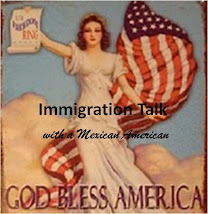 Of late, all has been quiet on the Immigration Reform front. Discussion Boards, both PRO and ANTI, have been quiet. Blogs have been quiet. There has been a significant amount of Political discussion, including here on my blog, but very little Immigration Talk.
Of late, all has been quiet on the Immigration Reform front. Discussion Boards, both PRO and ANTI, have been quiet. Blogs have been quiet. There has been a significant amount of Political discussion, including here on my blog, but very little Immigration Talk.The question of border security and the threat to U.S. security is back on the table even as the Presidential campaign progresses to the next phases. Senate Republicans plan to introduce a package of as many as 11 bills (could actually grow to 14) that establishes a hard line on illegal immigration. Even though experts consider it unlikely that these bills will reach the floor for debate, they reflect a move toward harsher immigration rhetoric and legislative proposals from both parties since Congress failed to pass a comprehensive overhaul in 2007. While some of the language in these possible pieces of legislation echo House bills, they go further. These bills include provisions to dock states 10% of their highway funds if they issue driver’s licenses to illegal immigrants. Another bill would extend the presence of National Guard on the border and still another would curtail language assistance at federal agencies and the voting booth for people with limited English ability. Senator Jeff Sessions, R-Ala, one of the leaders of the Republican efforts is offering a bill that would impose a maximum two-year sentence for the second offense of crossing the border illegally. Other bills:
● Block federal funding from cities that bar their police from asking about immigration status.
● Give the Department of Homeland Security the authority to use information from the Social Security Administration to target illegal immigrants.
● Require construction of 700 miles of fencing along the Southern border, not including vehicle barriers.
● Impose sanctions on countries that refuse to repatriate their citizens.
● Deport any immigrant, legal or illegal, for one drunken-driving conviction.
● Enable local and state police to enforce federal immigration laws
Its clear that immigration remains a political football in this Presidential election year. This includes the possibility of giving Senator McCain an opportunity to endorse one of the tougher bills to help distance him from some of his previous positions. Posturing or not, maybe some real immigration reform and border security measures will emerge from this, even though its an election year.
By: David Rogers and Patrick O'Connor Mar 5, 2008 05:40 AM EST
For seasonal employers, whether crabbers in Maryland or grand hotels in Michigan’s Upper Peninsula, the real calendar — not politics — makes the pressure very real and immediate. Immigration reform is raising its head again in Congress, stirring old hopes and fears among Democrats and forcing Republicans to re-evaluate their tactics given the re-emergence of John McCain. Nothing is anticipated on the scale of the comprehensive immigration bill that collapsed in the Senate last year. But seasonal employers, such as the restaurant and tourism industries, are pressing hard for more H-2B visas for lower-skilled workers this summer, and House Speaker Nancy Pelosi has promised Hispanic lawmakers an opportunity to add provisions addressing concerns in their community. A third potential piece is a bipartisan bill introduced by Rep. Heath Shuler (D-N.C.) — with the support of fellow “Blue Dog” Democratic moderates — that takes a more conservative approach: beefing up border security and requiring employers to use a government database to verify that their workers are in the U.S. legally. By Jay Fraser on March 5, 2008 at 10:53 PM













